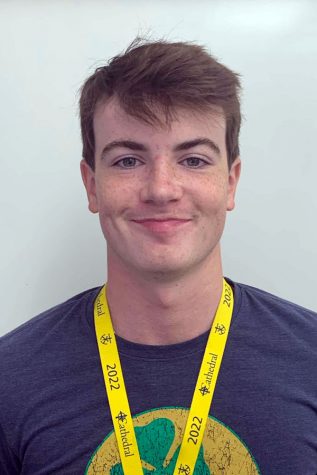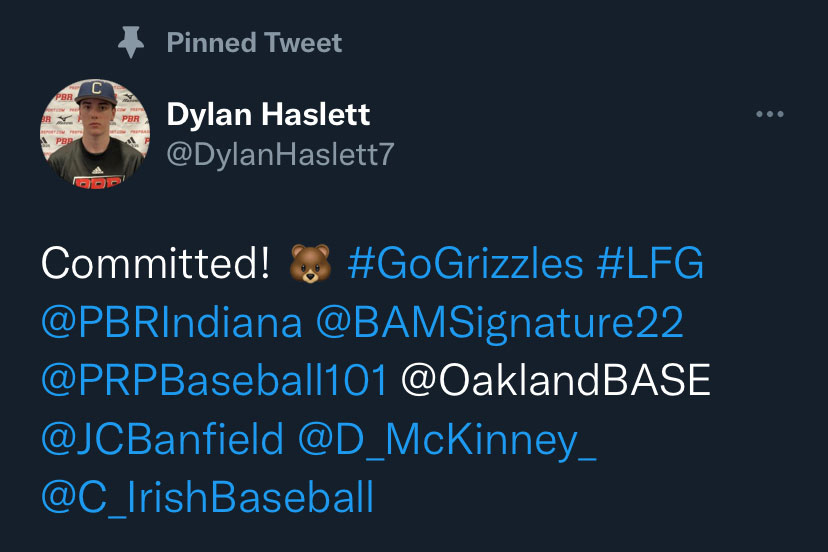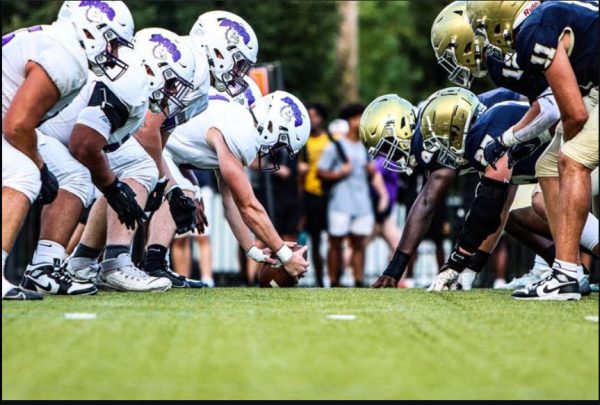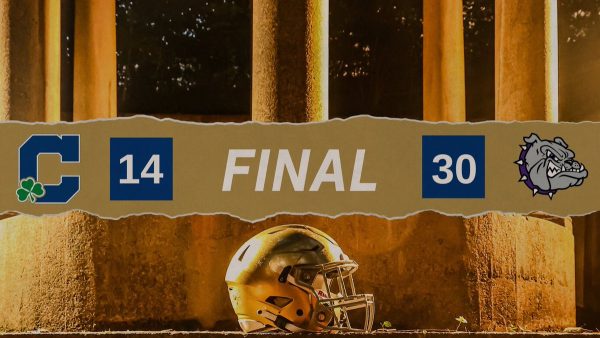Social media becomes integral to recruiting
But there are both advantages and disadvantages, coaches say
Senior Dylan Haslett used Twitter to announce his college decision.
With the Covid-19 shutdown almost two years ago, athletics at both the high school and club levels halted. Many could not play their sports, go to the gym and lift or take part in a team practice.
One of the biggest factors that affected those stellar student athletes was that they couldn’t be scouted because they were not playing. Even if they were competing, scouts were not able to attend because of the safety protocols set in place by the NCAA. That’s where social media began to have an even better role in recruitment.
Head Football Coach Mr. Bill Peebles ‘88 has had firsthand experience seeing what he called “social media recruiting” take place. He said, “Social media has had a huge impact. And really technology in general has had a big impact. A college coach can now access everything online, including film, which is one of the most important things. A college coach can search up a name of a player on HUDL, and his film will automatically pop up.
“Direct messaging is also a big thing that has changed as well. Coaches and scouts can now direct message athletes on their social media accounts.”
The primary apps used for recruitment are HUDL and Twitter, Peebles said. “HUDL allows kids to get film from games quickly and easily. It also allows our kids to create highlight reels and share them to college coaches. If a college coach likes the film, he can start contacting the kid and start the talking process.”
Basketball players also use social media to sell themselves to college coaches. Head Boys Basketball Coach Mr. Jason Delaney said, “Social media is huge for our guys from a recruiting standpoint. Especially with the name, image and likeness (NIL) deals that many guys are getting today, guys can go get paid for endorsements. You’re starting to see the more popular guys pop in their earnings because they’re getting paid more. There’s a huge business in social media recruiting nowadays.”
Delaney is also in the AAU circuit coaching for the Indy Heat Nike EYBL team. He uses Twitter as well to promote his players on his AAU squad and with the Irish. Delaney said, “Streaming games is now a big part of recruitment too. You have BallerTV and NFHS Network. Both are streaming services that allow college coaches to watch games from anywhere in the country so that they don’t have to travel.”
The coach said that one of the biggest factors in recruitment for his athletes involves finding the right fit. “You want a program or a coach that is going to take care of somebody and help them achieve their dreams. It’s also really important for me and our staff here at Cathedral. It’s like a father-son relationship.”
Delaney also gave a summary of how basketball recruiting works. “College coaches and scouts will come to high school games when they can. It’s just really difficult for the coaches because they are in season as well. We (The Irish) play in these showcases every year because they bring in more college coaches. A lot of recruitment comes from the AAU circuit. If athletes play in the right circuit, it’s a place that college coaches go because they’re all going to one place.
“Take the Nike EYBL for instance. They produce the most NBA draft picks and you’re seeing future draft picks go head to head in the EYBL. When college coaches request film, they want the whole thing. Some of them will ask for a good game and a bad game on film. They don’t want highlight videos, they want to see live action,” Delaney said.
Senior pitcher and Oakland University signee Dylan Haslett has his own recruitment story. He also grabbed the attention of college coaches through Twitter. “The first time I was heavily noticed by scouts was during the summer going into my junior year, and the fall going into that year,” Haslett said. He had interest from larger Division I schools but said he felt he could make an impact sooner at Oakland.
“When Oakland first reached out to me it was immediately after one of my best outings of my career. I threw against this loaded roster from Chicago with tons of DI talent on their squad. I ended that game with one walk, 11 strikeouts, six hits, and zero earned runs through six innings of work. My fastball sat 84 (to) 86 miles per hour, topping at 88. The last pitch I threw was an 86 mile-an-hour fastball which really grabbed their attention,” Haslett said.
Oakland happened to be scouting another player at the game Haslett pitched. After the game, Haslett said, “Oakland direct messaged me on Twitter. We hit it off from there and I committed later that fall.”
Haslett said, “One of the biggest things that helped me in my recruitment was obviously being in the weight room and getting stronger, but also going to showcase events. (Prep Baseball Report) and Perfect Game showcases really helped me out in my recruitment because my videos and stats published from those events validated my numbers and grabbed attention of a lot of scouts.”

Will Mayer is a sports editor for the Megaphone. He is a member of the varsity baseball team and is one of the school's two leprechauns this year. In his...







